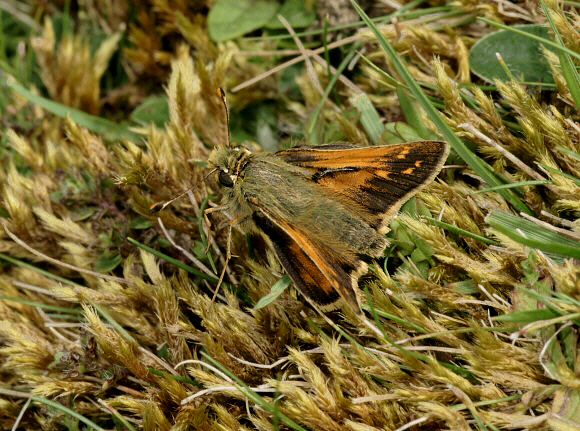 Silver-spotted Skipper Hesperia comma, male, Stockbridge Down, Hampshire – Adrian Hoskins
Silver-spotted Skipper Hesperia comma, male, Stockbridge Down, Hampshire – Adrian Hoskins
Introductio
The Silver-spotted Skipper is widely distributed in Europe, but absent from northern Britain, lowland regions of Spain and Portugal, southern Italy, the Mediterranean islands, and the Balkans. Beyond Europe it occurs in the Atlas mountains of Morocco, and across temperate Asia to Amurland. It also occurs over much of Canada and the western USA, where it is called the Holarctic Grass Skipper.
In Europe this butterfly can’t be confused with any other species except the Large Skipper Ochlodes venata, which is more brightly marked above, and lacks the distinctive silver spots on the underside hindwings of comma.
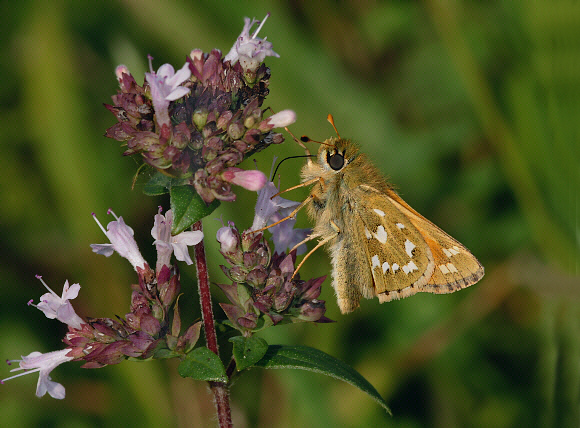 Silver-spotted Skipper Hesperia comma, Hampshire – Adrian Hoskins
Silver-spotted Skipper Hesperia comma, Hampshire – Adrian Hoskins
Habitats
In Europe this butterfly can be found in a very wide range of grassy habitats, and even occurs high on limestone mountains at altitudes of up to 2300m.
In Britain the butterfly was formerly found across most of southern and central England. Its range contracted severely during the 20th century, largely due to the elimination of it’s larval foodplant sheep’s fescue grass from many former sites as a result of agricultural improvement, afforestation, and urbanisation. The spread of myxomatosis greatly reduced the populations of rabbits during the latter half of the 20th century leading to a mass of local extinctions as sites on deeper soils quickly became overgrown with rank grasses. Since about 2002 the rabbit population has recovered from the affects of myxomatosis and consequently many grassland sites in southern Britain have become more heavily grazed and are now being slowly recolonised by this species.
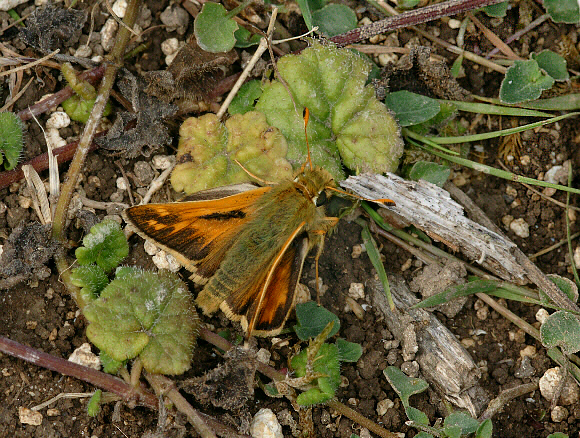 Silver-spotted Skipper Hesperia comma, male, Stockbridge Down, Hampshire – Adrian Hoskins
Silver-spotted Skipper Hesperia comma, male, Stockbridge Down, Hampshire – Adrian Hoskins
In England Hesperia comma is restricted to a few well drained and thinly soiled calcareous grassland sites in the southern counties where sheep’s fescue grass grows sparsely. On Silver-spotted Skipper sites extensive areas of bare ground are vital, and the sward is typically pock-marked with myriads of small bare patches exposed by rabbit excavations.
At most sites the populations are restricted to a limited area, typically on the upper slopes of south or east facing hillsides. However, at sites which are particularly exposed to the wind, or at higher altitudes, the populations tend to be limited to sheltered areas at the base of hills.
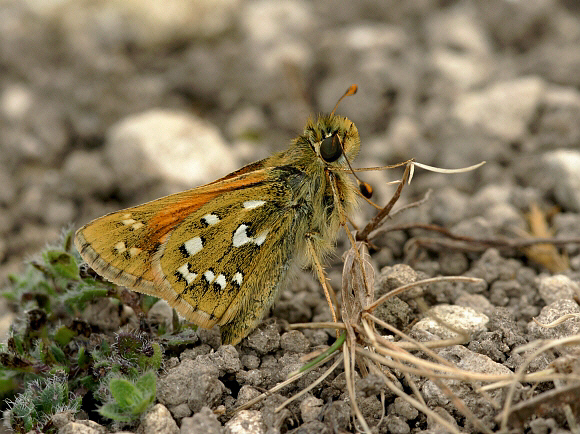 Silver-spotted Skipper Hesperia comma, male, Stockbridge Down, Hampshire -Adrian Hoskins
Silver-spotted Skipper Hesperia comma, male, Stockbridge Down, Hampshire -Adrian Hoskins
Lifecycle
In Europe and most of North America the butterfly is univoltine, but in Alaska the lifecycle takes two years to complete, the first winter being spent as an egg and the second as a fully grown caterpillar or chrysalis. In the hotter parts of the Mediterranean Hesperia comma over-winters as a fully grown caterpillar, amongst grass roots. In the UK the species always over-winters in the egg stage.
In Britain the butterflies emerge in mid-late July, and have a short flight period – no more than 2 or 3 weeks. At higher altitude sites such as Old Winchester Hill in Hampshire, the emergence time is generally about a week later than elsewhere.
Published material by Thomas states that females seeking egg-laying sites habitually settle in rabbit scrapes or on other small patches of bare ground, and then hop and walk until they locate a tiny tuft of sheep’s fescue grass, nearly always choosing plants that abut onto bare ground. My experience is that this is often not the case – most of the females which I have followed at Old Winchester Hill and Broughton Down dart about over short fescue sward and alight randomly on short grasses, usually well away from rabbit scrapes or other bare ground. They then thrust their abdomen forward to lay a single egg on a grass blade without any investigative hopping or walking about. After ovipositing they usually remain on the spot for a while before flying to another similar nearby spot where they repeat the process. Egg-laying behaviour probably varies from site to site according to local habitat and climatic conditions.
The straw-coloured eggs are laid singly on the narrow leaf blades of sheep’s fescue grass Festuca ovina. Suitable plants may be revisited by the same female several times, or they may be used by several different females, so it is possible to find up to a dozen eggs placed very close together.
The larvae are fully developed within the eggs by early autumn, but do not hatch until the following March. They feed nocturnally on the fine tender leaf blades, sheltering by day in a flimsy silken tent spun at the base of a grass tuft. When fully grown they are dark green, with a black head, and very wrinkled in appearance.
The chrysalis has a dark brown abdomen, and blackish wing cases and head. It is formed within a cocoon of coarse silk, at the base of grass tufts. The butterfly develops very quickly, emerging after only about 7 days.
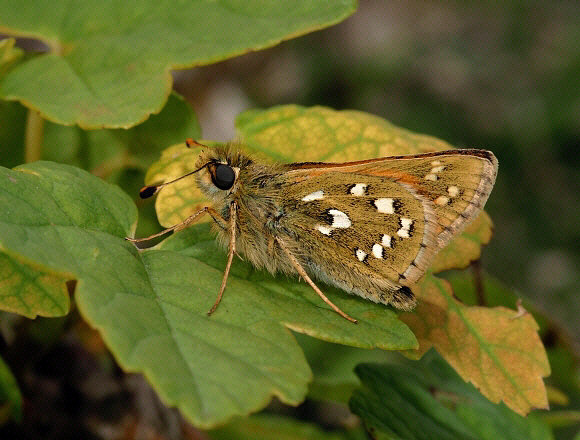 Silver-spotted Skipper Hesperia comma, male, Stockbridge Down, Hampshire – Adrian Hoskins
Silver-spotted Skipper Hesperia comma, male, Stockbridge Down, Hampshire – Adrian Hoskins
Adult behaviour
Silver-spotted Skippers only fly on warm sunny days. They are then extremely active, with a very rapid flight, zipping and darting about in every direction just above the surface of the ground. Once cloud begins to obscure the sun they settle to bask in rabbit scrapes, hoof prints, or on low foliage.
When conditions become too cool for flight they rest temporarily in tussocks of grass that abut onto bare ground, or settle on low foliage ( the male illustrated below for example was found on a tiny field maple sapling ). At such times they become extremely torpid. Overnight, they shelter in small bushes or amongst patches of dense foliage.
Both sexes nectar avidly at low growing flowers including stemless thistle, carline thistle, eyebright, stonecrop, bird’s foot trefoil, self heal, small scabious, lady’s bedstraw, hawkbit, devil’s bit scabious, red clover and autumn gentian. Their favourite nectar source however is wild basil – as illustrated by the activities of a male which I watched in August 2007 at Broughton Down. The butterfly visited 17 different wild basil plants in quick succession, completely ignoring all other flowers. After about 4 minutes I lost track of the butterfly when it got into a dog-fight with another male, but I continued to watch various other males that afternoon, and all showed a strong preference for wild basil, despite a profusion of other nectar sources.
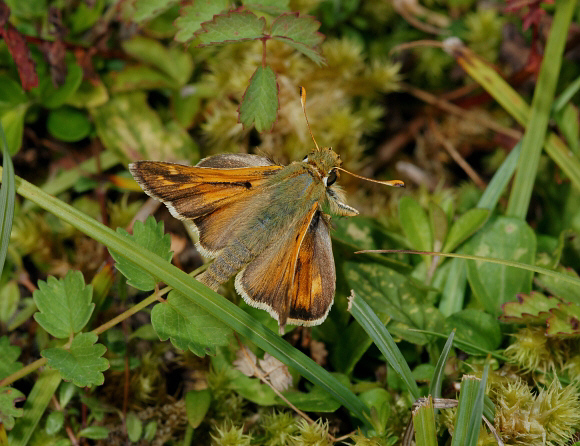
Silver-spotted Skipper Hesperia comma, male, Broughton Down, Hampshire – Adrian Hoskins
Males occupy loosely defined overlapping territories where they dart from flower to flower, stopping periodically to bask on patches of bare ground or on low herbage. They fly up instantly from these perches to intercept and investigate any small rapidly flying insect including flies, bees and wasps as well as other butterflies. They are very pugnacious in nature, and will chase off even the largest and most powerful butterflies, including Painted ladies and Dark Green Fritillaries, but rather oddly they completely ignore Burnet moths.
During male / male encounters, the butterflies zigzag rapidly, close to the ground, and then spiral upwards in tight circles until the weaker male is ousted, whereupon the other male returns to within a few metres of it’s original position.
When a virgin female is encountered she is abruptly forced to land on the ground, usually in a tuft of grass, where she vibrates her wings rapidly. The male lands alongside her, and buzzes excitedly around her, showering her with pheromones from his androconial scales. The female then flies in a series of short hops, until she finds a comfortable spot to settle, and the male then settles by her side, curving his abdomen round until he engages her. He then slowly turns to face away from her, after which the pair remain stationary in copulation for about 2 hours.
When a gravid female is encountered the ritual begins the same way, but after settling together 3 or 4 times in succession without successfully copulating the male flies off. There does not appear to be any visual rejection signal given to the unwanted male, so presumably mating only takes place of the female is receptive to the male pheromones.
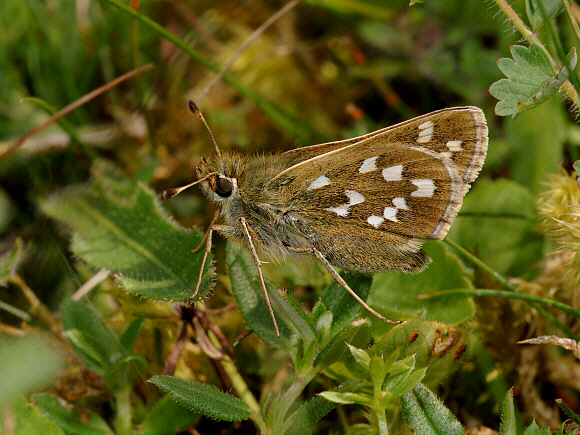
Silver-spotted Skipper Hesperia comma, female, Broughton Down, Hampshire – Adrian Hoskins
